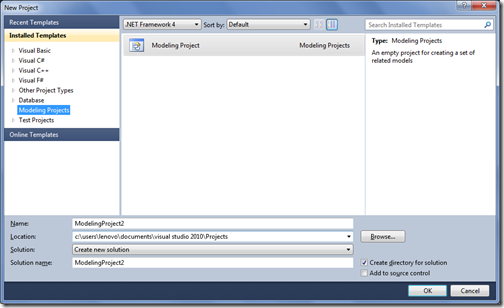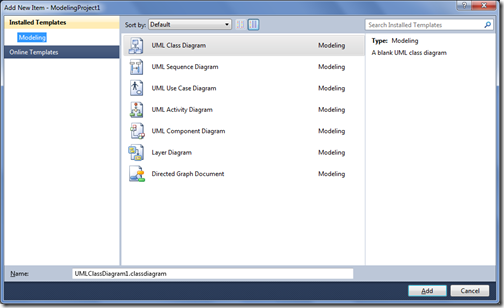Microsoft Visual Studio 2010 comes with great UML Features I will explain them in details in future post. But In this post I am going to explain the UML concepts because its necessary to understand UML concepts before moving to Visual Studio 2010 part. I know this post may sound very basic to some of people but its necessary to understand visual studio 2010 UML Features. So let’s start first basic question.
We will explore this each Diagram in great details in forthcoming posts.

After that You can add any diagrams and other components of the UML via right click project->add new item.

That’s it. We will explore all the features in great details in forthcoming posts. Stay tuned for more.. Hope this will help you..

What is UML?
UML means Unified Modeling Language its a standard language for specifying, visualizing, and documenting the artifacts of software systems as well as for business modelling . UML provide a set of engineering practice that has proven successful modeling of large complex and complex systems. In UML mostly graphical notations are used for expressing design concepts of software. Using UML software development team communicate,explore and architectural design of large scale projects.Goals and Advantages of UML
- Provide user a visually appealing modelling language
- Its provides extensibility and specialization mechanism to extend the software.
- Its independent of any programming language
- Its works better with Object Oriented Design concepts
- It integrates best practices
Why we need to use UML?
As you know software is now key part of any company production life cycle. Companies want to enhance their production life cycle with the help of software. So software industries are looking towards to automate the best practices,frameworks and patterns. UML language is defined to use this kind of things.Different Type of UML Diagrams
1) Class Diagram
This diagram displays contains classes,packages and structures. It displays the relationship between them and Inheritance also.2) Sequence Diagram
This diagram displays sequences of object and classes participating in the particular operation.3) Use Case Diagram
This diagram displays the relationship between the actors and user cases.4) Activity Diagram
This diagram displays the flow of the iteration. Here it describes the actions that are taken on particular objects5) Component Diagram
This diagram displays the code component of system. It displays high level structure of code itself. It also shows dependencies among the components.6) Layer Diagram
This diagram visualizes the logical architecture of the system.We will explore this each Diagram in great details in forthcoming posts.
Visual Studio 2010 and UML
Microsoft Visual Studio 2010 supports the Modelling Projects from where you can create different diagrams. Like following.
After that You can add any diagrams and other components of the UML via right click project->add new item.

That’s it. We will explore all the features in great details in forthcoming posts. Stay tuned for more.. Hope this will help you..



Great, it's very useful and important for Software Professional.
ReplyDeleteVisual Studio 2010 introduces modeling projects that bring UML diagrams to Visual Studio. Currently it is not possible to generate classes from diagrams automatically but I don’t think it is a problem – good UML diagrams visualize different aspects of system short and clearly and they usually don’t document everything you can find in system.
ReplyDelete